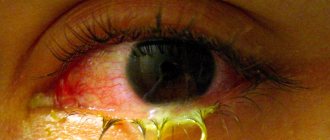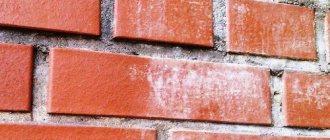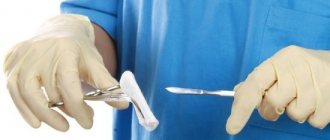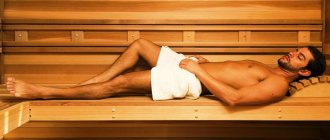A visit to the bathhouse is not only a hygienic procedure, but also a great way to relax your body and soul. The bathhouse has created favorable conditions for relaxation, healing and recuperation. But some are worried about red spots that appear with regularity after a bath. Today we will talk about this phenomenon.
The bath has a beneficial effect on metabolic processes in the body and helps improve the emotional state, but, unfortunately, for some people, a visit to the steam room is overshadowed by such an unpleasant phenomenon when the body becomes covered with red spots after the bath. Experienced visitors to steam rooms will not be surprised by this phenomenon, but beginners, encountering such a reaction of the body for the first time, can be seriously frightened. What is the reason for the appearance of red spots? Is this dangerous and should I see a doctor?
Statistics say that red spots after a bath appear in 10% of those visiting it and in most cases do not pose any threat.
Benefits of baths for skin
The steam room promotes intense sweating and evaporation of moisture.
With sweat, dirt, sebum, and dead cells come out of the pores. High temperatures lead to the death of pathogenic bacteria. Thanks to a visit to the bath, blood circulation improves, stimulates the sebaceous glands, and increases the firmness and elasticity of the skin. If you steam regularly:
- metabolic processes in the body are stabilized;
- the functions of the immune system are normalized;
- weight loss;
- the body will be cleansed of harmful substances.
Therefore, it is recommended to go to the bathhouse for people suffering from atopic dermatitis, eczema, urticaria, psoriasis, and rashes of various origins.
After a bath, red spots on the body: causes
After visiting the steam room, you may notice that red spots, rashes, pimples have appeared, and itching on the body and head.
Usually this phenomenon does not pose a health hazard. If the skin turns red in certain places, this is associated with dilation of capillaries and increased blood flow.
But sometimes the problem arises due to an allergic reaction not to the steam room itself, but to the objects that were used there. The body may react inadequately to gels or creams, as well as the water used to wash them off. Also, red spots on the body after a bath occur if you use water of unsuitable hardness. Sometimes an allergy to chlorine, which is used for disinfection, occurs. It also causes unbearable itching, forcing a person to scratch constantly. Chlorine dries out the skin and tightens it.
In a bathhouse, at high temperatures, the skin becomes more sensitive to any ingredients that come into contact with it, so even a previously familiar shampoo can cause discomfort.
To avoid allergies, you should select the most gentle cosmetic products for the bath.
Heat urticaria: symptoms and treatment
The appearance of a rash and itching of the skin after a hot bath or physical activity is caused by heat urticaria: it is observed with a frequency of 5-7% among the young population. A characteristic feature of any urticaria is the formation of itchy urticarial elements that pass without leaving marks on the skin.
Types of heat urticaria
There are two types:
- generalized cholinergic thermal urticaria,
- local form.
The first type is classified according to special forms. The second option is rare and is a type of urticaria caused by physical factors.
How does heat urticaria manifest?
Each form is characterized by clear symptoms.
The cholinergic type makes itself felt within 15–20 minutes after a provoking factor (stress, hot bath or shower, elevated air temperature, physical activity).
Small pinpoint rashes no more than 3 mm in diameter appear in the form of nodules on the upper part of the body. They are surrounded by a wide ring of redness (hyperemia). The rash tends to merge.
Cholinergic urticaria rash
Skin itching is severe and bothers the patient throughout the entire period of the rash. Often the rash is accompanied by general symptoms such as nausea, drooling, and loose stools. In most cases, the symptoms of thermal urticaria stop within 30–50 minutes after the end of exposure to the provoking factor, but they can persist for several hours.
The local form is characterized by the formation of large bubbles after 3–5 minutes in the area of thermal influence. Skin changes persist for about an hour. Cases of a combination of heat and cold urticaria have been described.
The disease can manifest itself for several months or years and then disappear without a trace. Less commonly, the disease lasts for decades.
Why does heat urticaria occur?
For the development of any form of illness, an allergic predisposition of the body is necessary. Some patients are diagnosed with other allergic diseases: food intolerance, atopic dermatitis, other types of urticaria.
In localized heat urticaria, histamine is directly released from mast cells upon local exposure to temperatures greater than 40ºC.
The cholinergic type is characterized by a general increase in body temperature after the action of provoking factors (physical activity, hot bath, stress, high air temperature). The thermoregulation center responds by releasing the neurotransmitter acetylcholine. This in turn stimulates the release of histamine from mast cells.
Diagnosis of heat urticaria
To determine the type and establish the causative factor, provocative tests are carried out.
To confirm the local form of thermal urticaria, apply a warm object (a glass of water heated to 40–46ºC) to the skin. The reaction is positive with the formation of bubbles and hyperemia. Another version of the test asks you to immerse your hand in water at the same temperature and note the appearance of the rash.
The cholinergic form is diagnosed when urticarial elements occur after being in a bath at a temperature of 40ºC or as a result of an exercise test. The effect is assessed after 5–30 minutes. Another test option is the intradermal administration of carbacholine, which is similar in composition and action to acetylcholine. The result is considered positive when bubbles of more than 15 mm appear.
What therapy is indicated for heat urticaria?
In case of a local form of the disease, it is necessary to stop exposure to heat. If the itching is very painful, antihistamines are prescribed.
The cholinergic form also requires elimination, if possible, of the provoking factor. A cool shower and stopping physical activity alleviate the condition. A good effect is achieved by using ointments with atropine or belladonna extract, taking into account the mechanism of action.
For severe manifestations, antihistamines are indicated. The drug of choice for this form will be Hydroxyzine. It has both anticholinergic and antihistamine effects, and has antiemetic and antispasmodic effects.
Considering the central mechanism of action on receptors, it causes sedation, which has a positive effect on the psycho-emotional causes of the development of generalized thermal urticaria. The drug is used in children from one year of age.
The dosage is selected according to the patient's age.
For severe manifestations, treatment of thermal urticaria involves the use of hormonal ointments. Additionally, sedatives are used for sleep disturbances due to itching.
Preventive measures are aimed at limiting the influence of provoking factors. When taking a bath or shower, the water temperature should be such that it does not cause symptoms of the disease. You should, if possible, reduce physical activity and try to reduce the impact of stressful situations.
Source: //allergolife.ru/teplovaya-krapivnica-simptomy-i-lechenie/
First aid
If after a bath the body is often covered with red spots, then you need to take into account the general condition of the body, and also pay attention to the color of the eyes.
If they turn red, then first aid should be provided. In this case, the body needs to give a short break and leave the steam room. This will reduce the speed of blood flow, normalize heartbeat and blood pressure.
It is important to measure your blood pressure. This is done before the procedure, after a quarter of an hour, and also when the first redness appears.
Monitoring blood pressure will allow you to choose the optimal mode of stay in the steam room, select the temperature and determine when the heart rate returns to normal.
To quickly achieve relief you should:
- leave the steam room;
- drink a glass of water at room temperature;
- close your eyes and relax;
- rest for 10-15 minutes.
Usually, after these activities, the skin regains its previous color and health improves.
Treatment
If after a steam room the body becomes covered with red spots, then to eliminate the defect, experts recommend rubbing a small amount of essential oil.
They make masks to quickly cope with hated red spots. Parsley, oatmeal, potatoes, and blue clay are added to the formulations.
If the problem is an allergic reaction, then the doctor will select antihistamines and local remedies to combat skin manifestations. In such cases, it is also recommended to follow a diet.
Elimination with medication
The use of medications without a doctor's prescription is unacceptable. In order to prescribe medications, you must first conduct a medical examination.
A patient with a similar problem may be prescribed antihistamines, as well as essential oils, which should be applied to the skin in small quantities.
In order to speed up the healing process, you should also limit your consumption of the following foods:
- fatty, smoked, salty and spicy;
- citruses and chocolate;
- semi-finished products and fast food.
How to behave correctly in a bathhouse
To prevent red spots from spreading throughout the body after a bath, it is recommended to determine a comfortable period during which you can safely sit in the steam room. Each person has individual indicators. To do this, you need to periodically record your body temperature and avoid raising it excessively. You should not overload the body, as this will negatively affect your overall well-being.
It is important to avoid common mistakes that people make when visiting a bathhouse:
- Do not wash your hair with cold water. This method is used to cool down. But during a sharp cooling, the blood vessels narrow and blood rushes to the head. This provokes headaches. Therefore, the temperature should be reduced gradually so that the blood vessels slowly constrict.
- Do not overuse brooms. If after using them there are marks that went away the next day, then there is nothing to worry about. But it’s not worth whipping the body to the point of abrasions.
- Do not apply creams or ointments to your skin before going to the steam room. Because of this, the pores will become clogged, and sweat will not come out of them when overheated. This will disrupt thermoregulation. In addition, all the harmful components that they hope to get rid of in the bath will not be able to leave the body.
- Do not overeat before the bath. Under the influence of high temperatures, the process of protein rotting begins in the intestines. This negatively affects the state of the entire digestive system, and especially the liver. But it’s unpleasant to go to the bathhouse on an empty stomach. Therefore, a light snack is allowed.
- Do not use soap in the steam room. It leads to dry skin. Therefore, you can wash thoroughly with soap before the steam room at moderate temperatures.
- Maintain individual temperature. If discomfort appears, your head begins to spin, your heart rate increases, you need to leave the room.
- Do not take a steam bath immediately after suffering from a cold. It is also prohibited to plunge into cold water. The body does not have time to recover in a short time, so you can get sick again.
- Use two brooms. First, you can whip the body with a birch broom, which will warm up the skin and open the pores, and after sweating increases, use an oak broom. Under its influence, the skin will become elastic and the pores will close.
If you follow these recommendations, then there will be no problems, and the bath will only bring health benefits.
Causes of marbled skin phenomenon
Since each person’s body is individual, it can react to wet steam in its own way.
Redness occurs due to a network of capillaries located close to the surface of the skin. When exposed to high temperatures, these small blood vessels dilate, allowing heat to be released. Therefore, for example, if a person is hot, a blush appears on the face.
Capillaries are divided into main and reserve (dormant) ones. There are few of the latter, and they are characterized by a bush-like arrangement. At normal temperatures, at rest, they do not manifest themselves in any way. In a hot and humid bath under increased loads, the main capillaries can no longer cope, and some of their “responsibilities” are taken over by reserve vessels.
It seems that in this case the skin should turn red evenly. But the fact is that the reserve capillaries expand much more slowly, so white spots appear at their location. When a person leaves the steam room into a cool room, the picture is identical. The main capillaries quickly narrow and the surface of the body turns pale. And the work of the reserve “comrades” is only gaining momentum, and red areas are already appearing in their place. As a result, you can observe the same marble skin. People also call it “leopard print”.
The question then becomes why some people have this reaction and others do not. This depends on the type and condition of the skin, on how close the capillary network is to the surface of the skin.









